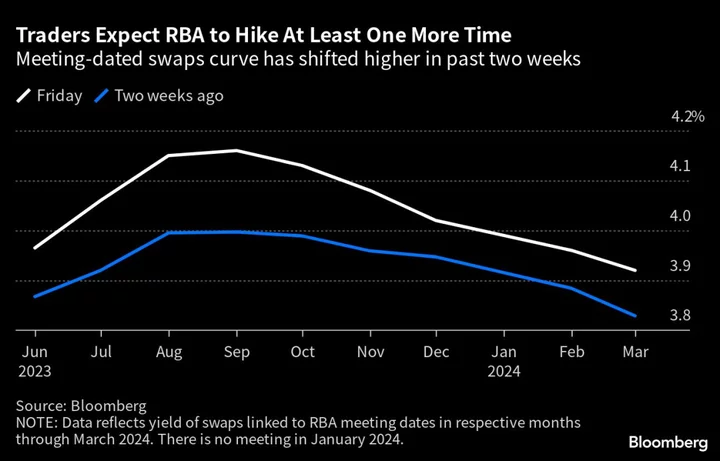Economists and money markets are divided over which way Australia’s central bank will move Tuesday as lingering price pressures and recovering home prices suggest a hike may be needed while weaker activity and rising unemployment argue for a pause.
About one-third of economists expect the Reserve Bank will raise its cash rate to 4.1% on Tuesday, including those from Goldman Sachs Group Inc. and Royal Bank of Canada, a Bloomberg survey of 25 analysts showed. The majority, including Commonwealth Bank of Australia, anticipate it will stand pat at 3.85%. Traders are pricing 50-50 odds.
“We consider the meeting now live,” said Gareth Aird, CBA’s head of Australia economics, ascribing a 70% chance of a hold while acknowledging the tightening risk. “The domestic economy is now showing sufficient signs of slowing.”
The RBA meets ahead of the Bank of Canada, a similar economy where policy makers are also this week seen considering a rate rise, and a week before the Federal Reserve which appears likely to pause its aggressive tightening cycle. An increase by Australia would put it out of step with Asia-Pacific peers, with New Zealand signaling its rate has peaked while Korea and India have stood pat.
Governor Philip Lowe took RBA-watchers by surprise last month when he unexpectedly hiked following a pause in April. His rhetoric has also turned increasingly hawkish in recent weeks as he worries about mounting upside risks to both inflation and labor costs.
Lowe reiterated last week that the board will do whatever is necessary to bring consumer price gains back down to the RBA’s 2-3% target, from around 7% now, as he tries to keep inflation expectations anchored.
The governor’s tough line came just before data showed consumer-price growth accelerated faster than expected in April. Two days after that, Australia’s industrial relations umpire raised the national minimum wage by 5.75%, a decision that prompted RBC and Nomura Holdings Inc. to predict a June hike.
“Like its global counterparts, the RBA is assessing whether policy is restrictive enough to ensure inflation returns to target within a reasonable timeframe,” said Su-Lin Ong, chief economist at RBC.
“Consumption and domestic demand are easing,” she said, but the labor market is extremely tight and wages are rising and these are “more pressing for policy considerations.”
Those calling for a rate increase also fret that higher inflation expectations could become entrenched if not tackled with urgency given recent global experience. In addition, a resurgent housing market together with soaring rents are also threatening to further fuel prices.
The RBA’s own forecasts show inflation only returning to the top of its target in mid-2025.
Lowe will have an opportunity to explain his decision and his broader assessment on the economy in a speech Wednesday morning in Sydney. Many economists expect the governor will signal further hikes ahead even if he decides to pause Tuesday given inflation is seen staying higher for longer.
Shortly after Lowe’s speech, the statistics bureau is due to release first-quarter gross domestic product. Economists favoring a pause say policy makers will wait to scour that data before moving again.
“We believe the RBA will want to see the actual national accounts data before acting, which rules out June,” said Citigroup Inc.’s Josh Williamson, predicting back-to-back rate rises in July and August.
Another worry is the looming expiry of a large number of home loans fixed at record low rates during the pandemic. Around 90% of fixed mortgages rolling off this year will see repayments increase by 30% or more, RBA research shows.
Australian households are among the most leveraged in the developed world, with a debt-to-income ratio of almost 188%, underscoring the need for the RBA to tread with caution.
“A 4% plus cash rate will push debt servicing costs into record territory as a share of household income,” said Shane Oliver, chief economist at AMP Capital Markets which is predicting a June hike.
--With assistance from Garfield Reynolds and Tomoko Sato.

